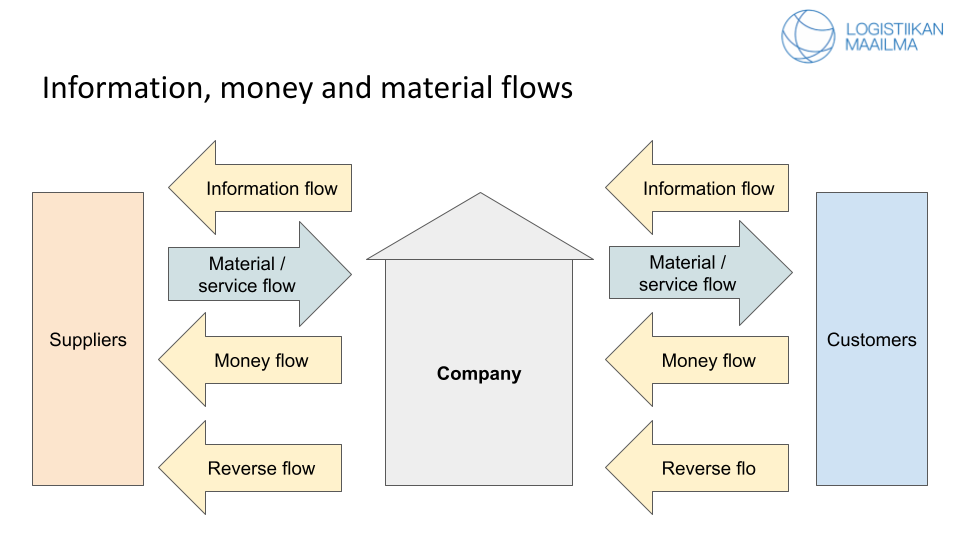Information, materials and money move from suppliers to customers and vice versa. Supply chain can be very long, if suppliers order products or raw materials from own suppliers and customers deliver products further to end-customers.
In logistics material flow goes at first from suppliers to customers (from upstream to downstream) and information and money flow from customers to suppliers (from downstream to upstream).
When it is a reverse flow (recycle stream) products however, return to suppliers. To enable efficient logistics, information should go naturally from suppliers to customers. Therefore, material, information and money flows move criss-cross. It should be emphasized that reverse flow can be connected with another flow or money flow. In this case, money flow refers to money, recipient of recycle material pays for recyclable material. For example, one gets compensation for recycling bottles and scrap metal.
The following diagram illustrates logistics information, money and material connection with each other.

Information flow
In logistics is a large number of information exchange on sales and inventory amounts and forecasts, ordering transport, confirmation and invoicing as well as various types of contracts and terms of delivery.
Logistics can be perceived as information flow that starts with customer demand forecast or its realization, which moves along the chain to factory, raw material suppliers, warehouse, drivers and to other service providers and subcontractors. In addition, authorities such as customs and tax authorities need their own information. All supply chain parties should receive adequate information to be able to do their part in customer needs satisfaction in a timely manner. In addition, chain includes a huge number of different contracts and foreknowledge and confirmations and change notifications, so that the products are in required order and at the right time in the next phase of supply chain.
Material flow
Material flow includes transporting and storage of materials or products. If material flow goes well, it shows, in practice e.g. as short delivery time of a product and ultimately as customer satisfaction. Material flow requires information flow, against good logistics principles is that if material is delivered although no-one has information about it. Information must, however, be attached to material and to product. For example, packaging must include information on the content, sender and destination.
Capital or Money flow
Capital i.e. money flow is a compensation to be paid for raw materials and products and thus it is contrary to material flow. Usually money flow is behind material flow.
In addition, substantial capital is involved in logistics chain. Capital is tied up in the goods maintained in warehouses and intermediate terminals. Also, considerable capital is tied up in the goods being transported. Transport and storage costs themselves are a major cost factor.
In addition, packing goods and planning logistics chain, implementation and management cause costs.
In this context, logistical costs can be divided into
- transport costs
- storage costs
- administration costs
- packing costs and
- capital costs.
Reverse flow
Reverse flow is a waste or by-product flow removed from different stages of material flow as well as managing discarded products back for recycling or final disposal. This also includes reverse logistics.
Sivu päivitetty / tarkistettu 30.4.2021.
